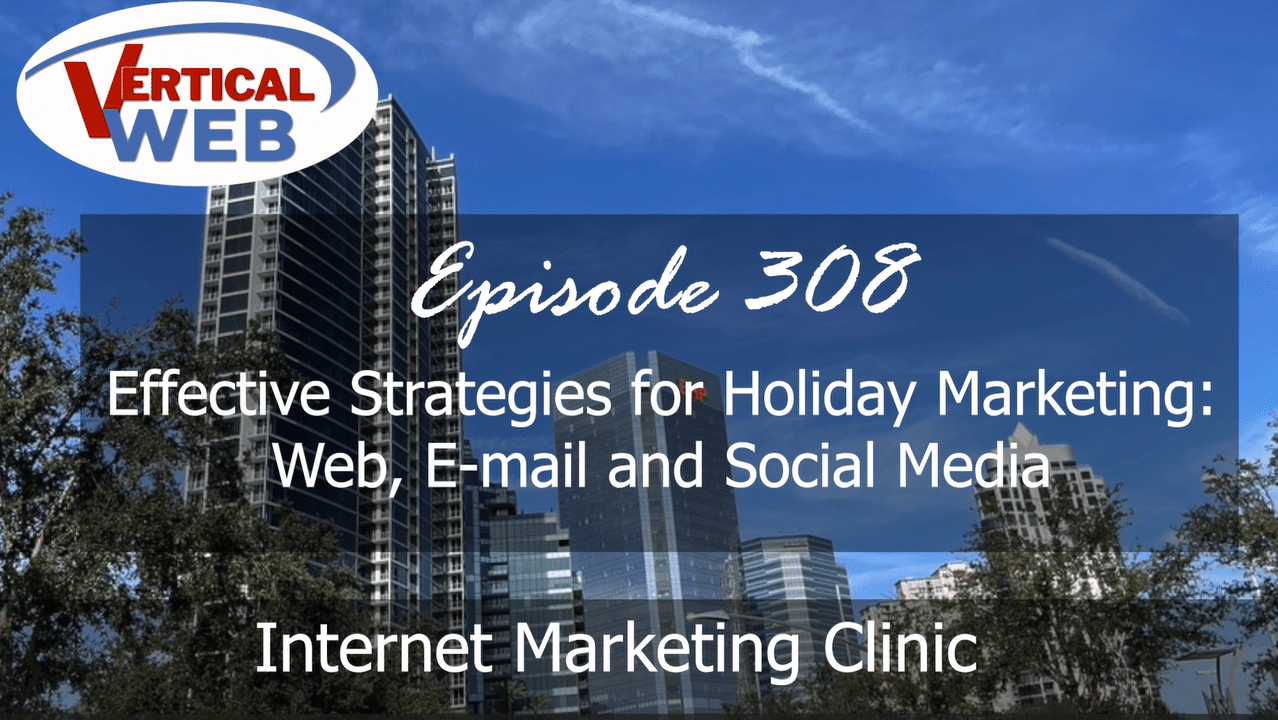Subscribe to Our Podcast Apple Podcasts | RSS
Fall is upon us, which means the holidays are soon to follow. For business owners, this time of the year is filled with opportunity – opportunities to develop your brand and capture a new wave of customers in the process.
Of course, the competition is fierce during the holidays, especially as we near Black Friday and Christmas. That means SMB owners and online retailers must be ready to optimize their web presence to the extent they can. By strengthening your website, ad marketing, e-mail marketing and social media marketing channels, you’ll give your business a fighting chance to rise above the holiday noise this year.
Here, we’ll address how to do just that.
First, start by optimizing your Google Business Profile and integrating analytics
Whether your business operates globally or locally, optimizing your Google Business Profile (GBP) is a strong – and simple – first step. For local SMBs, it’s unavoidable – your company needs a locally optimized GBP to garner traction with Google.
Start by making sure your company’s name and address are accurate. Put up a photo of your company’s building. Fill out as much of your profile as you can – posts, reviews, events – all of these signals add up to let Google know where your business is located. And ensuring your business is properly geolocated by Google is a must-do to achieve any degree of local SEO success. Use geo-specific keywords in your company’s description and posts. Publish photos and videos (that you or someone within the company has taken) regularly. Just make sure that the company’s profile is active and frequently updated.
Take a few minutes and integrate Google Analytics (widely termed GA4) into the website, too. It’s quick and easy to do so, and it provides valuable insight into how your site is performing from a traffic and lead-capturing standpoint. Users, sessions, page views, conversions, bounce rate, engagement time – there’s a lot of data here, but you don’t need to be a digital marketing expert to extract value out of it.
Create more customer touch points through e-mail and social media
As the holiday season approaches, consumers start gearing up to buy. That means it’s time to get your brand in front of them. With so much online noise competing for our attention these days, consistent (but not obnoxious) touch points are needed to drive leads to your company.
A proven way to do this is with e-mail marketing – Mailchimp is our preferred tech for automating many e-mail marketing functions, but you’ll need to provide the content.
Ideally, this content will provide valuable information that’s designed to “hook” the user toward your website. At the least, taking a spot in their inbox will bring your brand to the front of their mind – the first step toward making a conversion.
Don’t be afraid to regularly send out these e-mail blasts – a couple times a week is considered optimal – and make an effort to capture user e-mails when they visit your site or make a purchase through your business. It’s easier to sell to current customers than new ones, and that means you’ll need an updated e-mail list.
E-mail marketing can also be used to pick up additional customer reviews
Customer reviews are weighted heavily by Google for SEO purposes. They are, therefore, a high-value target for brands. E-mail marketing can also support this goal by (politely) reminding users to leave a review. Many buyers have no problem doing this, they just need to be asked.
Don’t overthink it. A week after a customer buys something from your site, automate your e-mail marketing platform to send out a review request/reminder. It’s a no-risk, high-reward approach to building your brand’s reputation.
The Google Display Network provides a brand awareness boost for pennies on the dollar
Chances are, you’ve seen plenty of small ads served through Google’s Display Network (GDN). The GDN is one of Google’s many, and often confusing, advertising platforms that allow companies to reach customers wherever they go. You’ll find GDN ads everywhere – on search engine results pages, e-commerce pages, forums, blogs and so on.
Brands have some control over where their GDN ads are published, but the real advantage here is the sheer volume of impressions companies can capture through GDN ads. There are millions of websites participating in the network, so your ads could potentially be seen by many, many people. It’s also inexpensive for the potential return, so for SMBs that need to drum up some quick brand awareness, it’s a no-brainer for the holiday season.
Act like an expert and write like an expert – with a little help from AI
Let’s introduce artificial intelligence into this conversation. AI writing tools – ChatGPT best known among them – have added another dimension to content creation. At first glance, AI looks like a perfect way to quickly develop a ton of content, saving business owners the time and challenge that often comes with writing.
But while AI can help support better and more efficient writing, it’s no replacement for a true, human expert.
That’s because Google wants unique, expert level content, not just keyword-rich and topic-relevant content. AI can generate a ton of words, but those words are “scraped” from the internet. Put another way, AI writes by pulling from existing content all over the web. It’s fast and achieves a base level of competence, but AI cannot insert unique experiences or bits of expert insight that only an industry veteran can offer.
Unfortunately, Google is adept at tracking this, so it can identify websites filled with AI content. And though the search engine juggernaut’s opinion on AI content is still in flux – Google is developing its own AI search assistant, after all – sites that depend on AI are being penalized on the SERPs.
Here’s how to make AI work for your content writing
The best approach for business owners is to take on a subject matter expert (SME) role within their industry. If you own a business in the field, you’re an expert in the field. And as an industry expert, you are capable of bringing that uniqueness to your site’s content.
Currently, we draw the AI writing line at blogs and permanent website content (landing page stuff, mainly). These should be heavily human-written given their critical importance to the site’s SEO and user experience. Product pages, sales letters, social media posts – these are better suited to ChatGPT and similar tools.
If you’re starting off on a blog or piece of site content, here’s one way to bring in ChatGPT as your AI assistant:
- Generate a list of relevant keywords – Keywords are terms that Google uses to understand what the surrounding content is about. These terms are typically search queries themselves or encapsulated inside a search query. Though Google’s crawlers have become much more sophisticated in their ability to understand content, keywords still play an important role. ChatGPT, if asked, can provide a list of keyword terms to include in your writing. Doing so will help Google interpret and categorize your content for better SERP placement.
- Develop a list of content angles – You can also ask ChatGPT to provide a list of ideas for your particular topic. If prompted, AI will generate a list of suggestions that could go in your blog. Not all of them will be a fit for your blog, but you may find an idea or two that you hadn’t considered and would make a good addition. This may also help with creating follow-up content and a longer term strategy for tackling the topic.
- Form the general structure of the page – ChatGPT can tweak its output by length, tone, target audience and more, as long as you ask it to. If you’re writing a blog and aiming for 1,500 words and targeted toward younger consumers, ask it to include those filters and you’ll get a slightly different piece of content. This can be used as a kind of bird’s eye view of how the content should read and how it should be structured.
At this point, you’ve got the skeleton of a page, content ideas that you can use to help develop it further and a list of high-value terms that will help Google understand what the content is about. As the SME, you’ll need to ensure the content’s accuracy (AI will confidently generate the occasional error), “humanize” it with unique turns of phrase and sentence structure, and add important pieces of industry expertise to charge it with value.
With the holidays upon us, tis the season to boost your digital marketing
We’re mere weeks away from peak purchasing season among consumers, so it’s time for business owners to tighten up their online marketing. If you have a website, but don’t know where to begin with optimizing it for search engines, the above steps will give your brand an extra push – and some extra customers, likely. If you’d like to further your impact, contracting a firm experienced in digital marketing can be the best decision for your business success.
- Google Leaks and What They Mean for SEO and Small Business from an SEO Expert - July 19, 2024
- SEO Hacks: Easy Ways to Win at SEO - June 8, 2024
- Last Call for Todays Class Get Your Business On the Map – - May 22, 2024


